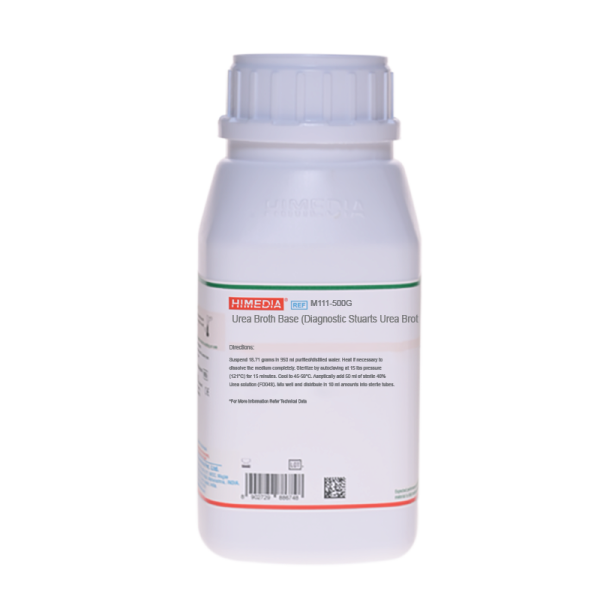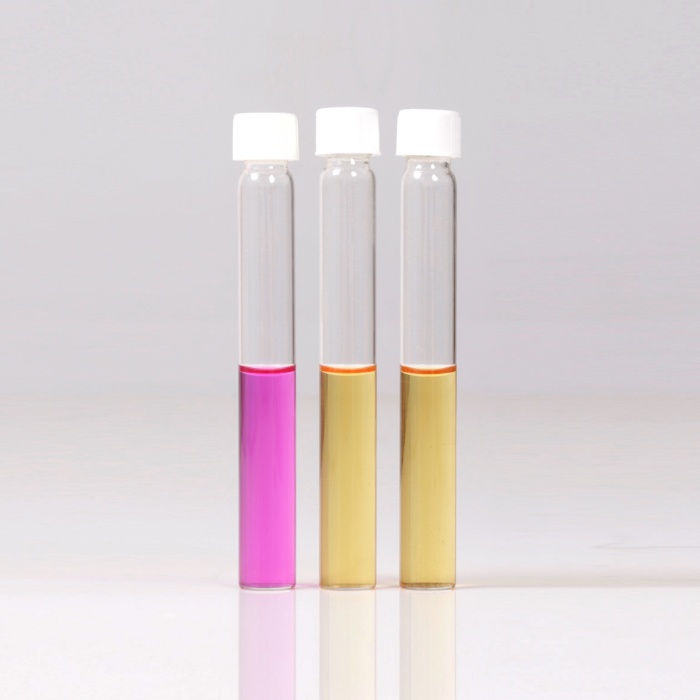 Your enquiry has been submitted
Your enquiry has been submitted
Diagnostic Stuart’s Urea Broth Base (Urea Broth Base)
Intended Use
Recommended for the identification of bacteria on the basis of urea utilization, specially for the differentiation of Proteus, Salmonella and Shigella species from clinical and non-clinical species.
Composition
| Ingredients | g/L |
|---|---|
| Potassium dihydrogen phosphate | 9.100 |
| Di-potassium hydrogen phosphate | 9.500 |
| Yeast extract | 0.100 |
| Phenol red | 0.010 |
| Final pH (at 25°C) | 6.8±0.2 |
**Formula adjusted, standardized to suit performance parameters
Directions
Suspend 18.71 grams in 950 ml purified/distilled water. Heat if necessary to dissolve the medium completely. Sterilize by autoclaving at 15 lbs pressure (121°C) for 15 minutes. Cool to 45-50°C. Aseptically add 50 ml of sterile U40 Supplement (FD048). Mix well and distribute in 10 ml amounts into sterile tubes.
Principle And Interpretation
Rustigian and Stuart developed Urea Broth (1). This medium is especially recommended for the differentiation of Proteus species from Salmonella and Shigella species in the enteric infection diagnosis (2), based on urea utilization (3,4). Gram-negative enteric bacilli are unable to utilize urea because of less nutrients and high buffering capacity of the medium. Urea Broth becomes alkaline as the utilization of urea by the organisms liberates ammonia during the incubation, indicated by pink red colour. All urea test media rely on the alkalinity formation and so they are not specific for urease testing. The utilization of proteins may raise the pH to alkalinity due to protein hydrolysis and excess of amino acids results in false-positive reaction. A medium without urea serves as negative control to rule out false positive results.
Type of specimen
Pure isolate
Specimen Collection and Handling
For food and dairy samples, follow appropriate techniques for sample collection and processing as per guidelines (5,6,7).
For water samples, follow appropriate techniques for sample collection, processing as per guidelines and local standards (8).
For clinical samples follow appropriate techniques for handling specimens as per established guidelines (9,10).
After use, contaminated materials must be sterilized by autoclaving before discarding.
Warning and Precautions
In Vitro diagnostic use. For professional use only. Read the label before opening the container. Wear protective gloves/protective clothing/eye protection/face protection. Follow good microbiological lab practices while handling specimens and culture. Standard precautions as per established guidelines should be followed while handling clinical specimens. Safety guidelines may be referred in individual safety data sheets.
Limitations
- Prolonged incubation may cause alkaline reaction in the medium.
- Also, all urea test media rely on the alkalinity formation and so they are not specific for determining the absolute rate of urease activity (4).
Performance and Evaluation
Performance of the medium is expected when used as per the direction on the label within the expiry period when stored at recommended temperature.
Quality Control
Appearance Light yellow to light pink homogeneous free flowing powder
Colour and Clarity of prepared medium Yellowish orange coloured clear solution in tubes.
Reaction Reaction of basal medium (1.87gm in 95ml distilled water) at 25°C. pH : 6.8±0.2
pH 6.60-7.00
Cultural Response Cultural characteristics observed on addition of sterile U40 Supplement (FD048) after an incubation at 35-37°C for 18-24 hours.
| Organism | Urease |
|---|---|
| Escherichia coli ATCC 25922 (00013*) | negative reaction, no change |
| # Klebsiella aerogenes ATCC 13048 (00175*) | negative reaction, no change |
| Proteus mirabilis ATCC 25933 | positive reaction, cerise colour |
| $ Proteus hauseri ATCC 13315 | positive reaction, cerise colour |
| Salmonella Typhimurium ATCC14028(00031*) | negative reaction, no change |
Key: *Corresponding WDCM numbers.
# Formerly known as Enterobacter aerogenes
$ Formerly known as Proteus vulgaris
Storage and Shelf Life
Store between 10-30°C in a tightly closed container and the prepared medium at 2 - 8°C. Use before expiry date on the label. On opening, product should be properly stored dry, after tightly capping the bottle in order to prevent lump formation due to the hygroscopic nature of the product. Improper storage of the product may lead to lump formation. Store in dry ventilated area protected from extremes of temperature and sources of ignition Seal the container tightly after use. Product performance is best if used within stated expiry period.
Disposal
User must ensure safe disposal by autoclaving and/or incineration of used or unusable preparations of this product. Follow established laboratory procedures in disposing of infectious materials and material that comes into contact with clinical sample must be decontaminated and disposed of in accordance with current laboratory techniques (9,10).
Reference
- Rustigian and Stuart, 1941, Proc. Soc. Exp. Biol. Med., 47:108.
- Finegold and Baron, 1986, Bailey and Scotts Diagnostic Microbiology, 7th ed., The C.V. Mosby Co., St. Louis.
- Christensen, 1946, J. Bact., 52:461.
- MacFaddin J. F., 2000, Biochemical Tests for Identification of Medical Bacteria, 3rd Ed., Williams and Wilkins, Baltimore. Md.
- American Public Health Association, Standard Methods for the Examination of Dairy Products, 1978, 14th Ed., Washington D.C.
- Salfinger Y., and Tortorello M.L. Fifth (Ed.), 2015, Compendium of Methods for the Microbiological Examination of Foods, 5th Ed., American Public Health Association, Washington, D.C.
- Wehr H. M. and Frank J. H., 2004, Standard Methods for the Microbiological Examination of Dairy Products, 17th Ed., APHA Inc., Washington, D.C.
- Lipps WC, Braun-Howland EB, Baxter TE, eds. Standard methods for the Examination of Water and Wastewater, 24th ed. Washington DC:APHA Press; 2023.
- Isenberg, H.D. Clinical Microbiology Procedures Handbook. 2nd Edition.
- Jorgensen, J.H., Pfaller, M.A., Carroll, K.C., Funke, G., Landry, M.L., Richter, S.S and Warnock., D.W. (2015) Manual of Clinical Microbiology, 11th Edition. Vol. 1.
| Product Name | Diagnostic Stuart’s Urea Broth Base (Urea Broth Base) |
|---|---|
| SKU | M111 |
| Product Type | Regular |
| Physical Form | Powder |
| Origin | Animal Free (Microbial) |
| Packaging type | HDPE |
| References | 1. Rustigian and Stuart, 1941, Proc. Soc. Exp. Biol. Med., 47:108. 2.Finegold and Baron, 1986, Bailey and Scotts Diagnostic Microbiology, 7th ed., The C.V. Mosby Co., St. Louis. 3.Christensen, 1946, J. Bact., 52:461. 4.MacFaddin J. F., 2000, Biochemical Tests for Identification of Medical Bacteria, 3rd Ed., Williams and Wilkins, Baltimore.Md. |
| Customized Product Available | No |








